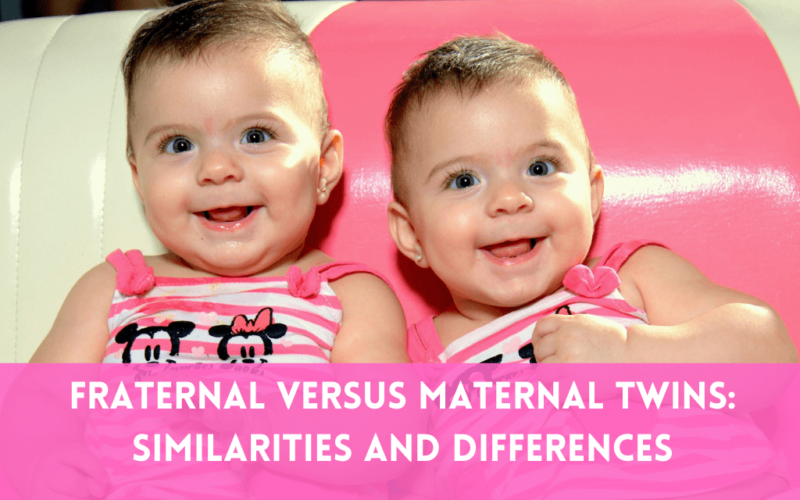Having twins means having two babies at the same time within the same pregnancy. Twins are classified into two major categories worldwide: fraternal and maternal.
There are many similarities as well as dissimilarities between the fraternal vs maternal twins. Knowing these can play a great role in taking better care of the twins’ health, growth, and other developments.
What are fraternal and maternal twins?

Fraternal or non-identical twins are twins that have developed from two different eggs that were fertilized by two different sperms. They are also known as dizygotic twins.

On the other hand, to define maternal twins, twins that were developed from one fertilized egg that then split into two, developing two embryos. These twins are also called monozygotic twins.
Are There Other Types and Subtypes of Twins?
Even though fraternal and maternal twins are the main two types there are many other rare types of twin babies. Moreover, there are several subtypes of both fraternal and maternal twins. It is important to know about those as well in order to have a thorough understanding of the concept of twins without the scope for any confusion.
Paternal and maternal twins
“Are twins maternal or paternal?” This is a question that often confuses the parents. However, the answer is simple. As we have discussed above, maternal twins stand for identical/monozygotic twins.
They are called so because the same egg that causes the twin pregnancy comes from the mother. Now, when it comes to paternal twins meaning, they are again a synonym for fraternal/dizygotic twins. They are called paternal because two or more sperms from the father are involved in the formation of this type of pregnancy.
Mo/mo, di/di, and mo/di twins
These types of twins are categorized depending on which stage of development the zygote divides or splits.
Mo/Mo (monochorionic monoamniotic) twins share the same placentaand chorionic and amniotic sacs. They are developed if the split happens between eight to twelve days after fertilization.
Mo/di (monochorionic diamniotic) twins share the same placenta and chorion but have separate amniotic sacs. They form when the divide occurs between four to eight days after fertilization.
Di/di (dichorionic diamniotic) twins have their own placenta, chorionic sacs, and amniotic sacs. These twins are developed when the split occurs at the earliest stage after fertilization, usually within 1 to 4 days. Most fraternal twins are di/di twins.
Unusual maternal twins
There are some rare and unique subtypes of identical twins such as mirror twins, conjoined twins, semi-identical twins, etc. For mirror twins, the physical features of one are the complete mirror image of the other. Their hair, teeth, dominant hand, etc are the opposite of each other. Again, for conjoined twins, the twins are physically attached to each other. In some cases, they also share vital organs.
Another rare subtype is semi-identical twins, where one egg is fertilized by two different sperm. Here the twins share the same DNA from their birthing parent but only 50 percent of the DNA from their n0n-birthing parent.
Unusual fraternal twins
Just like maternal twins, fraternal twins have their fair share of unique subtypes. Twins with different ages, different fathers, and different skin colors are some of those.
What are the similarities between fraternal and maternal twins?
Both types of twins share some similarities. To begin with, both fraternal and maternal twins are twins that are formed during the same pregnancy. Again, both sets of twins also share similarities in terms of their genetics. Moreover, be it fraternal or maternal, each of the twins will surely have different fingerprints.
No matter what type of twins you are going to have, you will need some must-have products that cater to twin babies. You can consider getting double strollers for the sake of your convenience of moving the babies once they arrive.
What Are The Differences Between maternal vs Fraternal Twins?
The first main difference between fraternal and maternal twins is that fraternal twins are dizygotic and maternal twins are monozygotic. This means fraternal twins come from two separately fertilized eggs and have their own placenta, amnionic and chorionic sacs. On the other hand, maternal twins are monozygotic, meaning they share the same placenta.
Again, as fraternal twins are developed by separate eggs and sperms, they share only 50% of the DNA whereas identical twins share the same DNA.
Also, the difference in fraternal and identical twins can be seen when it comes to their gender. In the case of fraternal twins, they can be of the same gender or have different genders. If both the fertilizing sperm contain the same sex chromosomes (X,X or Y,Y) then the twins will have the same genders.
However, if one egg is fertilized by an X sperm and the other egg is fertilized by a Y sperm then the fraternal twins will have different genders. On the contrary, as maternal twins are formed through the division of one fertilized egg, the twins will always have the same gender.
Moreover, there is also a difference between fraternal twins vs identical twins when it comes to blood groups. Fraternal twins might have the same or different blood groups. However, identical twins have the same blood group.
Additionally, identical twins have almost identical physical appearances while fraternal twins might look similar or completely different from each other. There is also the question of heredity. While fraternal twins can occur hereditarily, no such reasoning has been found in the researches that search for the causes of maternal twins.
Why Is It Important to Know If Your Twins Are Fraternal or Identical?
It is always wise to be informed about one’s health in order to make informed choices while navigating life. In the same vein, it is important to know whether your twins are identical or fraternal. For instance, identical twins are prone to the same kinds of illnesses or health conditions in most cases. They both might have high blood pressure, diabetes, etc. They can be checked for early symptoms if the parents know for sure what type of twin they are.
Again, identical twins will always be compatible for organ transplants if necessary due to their identical genetic make-up. On the other hand, fraternal twins are not always compatible in this regard.
Other reasons for knowing if your twins are identical or fraternal involve knowing the chances of having future twin pregnancies (as only fraternal twins can be developed due to genetics), answering questions of family and friends, being part of twin research, and overall curiosity about the whole phenomenon, etc.
Is It Possible to Induce Fraternal and Maternal Twin Pregnancy?
Of the two types, fraternal twins are the most common. Almost two-thirds of all twin pregnancies occurring around the world are fraternal twins. It can happen due to natural factors like genetics, mother’s age, hyperovulation in the mother, number of pregnancies, etc.
Other than that, through fertility treatments like IVF, it is possible to induce fraternal twin pregnancies artificially. However, CDC guidelines say that twin pregnancies are riskier than single pregnancies in many aspects, be they IVF induced or not. So, you should proceed with caution and think about all the risks before trying to induce a twin pregnancy,
On the other hand, maternal/identical twins are less common among twins. Only one-third of the total twins are identical twins. Maternal twins develop due to the splitting of one zygote. The reasons and factors behind this split are still unknown to this day. As a result, inducing identical twin pregnancies is likely to be impossible as of today’s science and technology.
Conclusion
In conclusion, both fraternal ar maternal are two types of twins that develop during the same pregnancy. Fraternal twins form from two different eggs that were fertilized by two different sperm. They are non-identical and dizygotic. Maternal twins are formed when a single zygote splits into two after fertilization for some unknown reason. Maternal twins are identical and monozygotic.
They have many differences between them even though some similarities can also be accounted for, the main difference being the degree of identity and mechanism of formation. It is vital to know about the distinction between the two types of twins in order to ensure your twins’ healthy and informed life.







